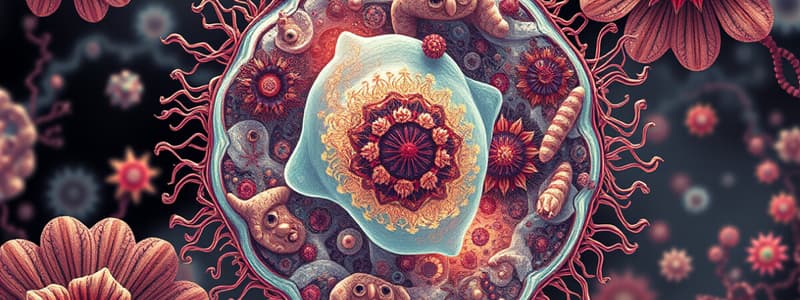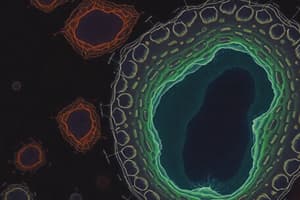Podcast
Questions and Answers
Cells are the fundamental units of ______.
Cells are the fundamental units of ______.
life
Prokaryotic cells lack a defined ______.
Prokaryotic cells lack a defined ______.
nucleus
Mitosis results in two identical ______ cells.
Mitosis results in two identical ______ cells.
daughter
Chloroplasts are found in ______ cells and are responsible for photosynthesis.
Chloroplasts are found in ______ cells and are responsible for photosynthesis.
The ______ is known as the powerhouse of the cell.
The ______ is known as the powerhouse of the cell.
Cellular respiration converts glucose and oxygen into ______.
Cellular respiration converts glucose and oxygen into ______.
The ______ apparatus modifies, sorts, and packages proteins and lipids.
The ______ apparatus modifies, sorts, and packages proteins and lipids.
In meiosis, four non-identical daughter cells are produced with ______ the chromosome number.
In meiosis, four non-identical daughter cells are produced with ______ the chromosome number.
The jelly-like substance within a cell is known as ______.
The jelly-like substance within a cell is known as ______.
Anabolism is the process that ______ complex molecules.
Anabolism is the process that ______ complex molecules.
Flashcards are hidden until you start studying
Study Notes
Cell Biology
Basic Unit of Life
- Cells are the fundamental units of life.
- All living organisms are made up of cells.
Types of Cells
-
Prokaryotic Cells
- No nucleus; DNA is in the nucleoid region.
- Generally smaller and simpler.
- Example: Bacteria and Archaea.
-
Eukaryotic Cells
- Have a defined nucleus containing DNA.
- Larger and more complex.
- Examples: Plant cells, animal cells, fungi, protists.
Cell Structure
-
Plasma Membrane
- Semi-permeable barrier that regulates entry and exit of substances.
-
Cytoplasm
- Jelly-like substance where cellular processes occur.
-
Organelles
- Specialized structures within cells:
- Nucleus: Contains genetic material (DNA).
- Mitochondria: Powerhouse of the cell; energy (ATP) production.
- Endoplasmic Reticulum (ER):
- Rough ER: Studded with ribosomes; synthesizes proteins.
- Smooth ER: Involved in lipid synthesis and detoxification.
- Golgi Apparatus: Modifies, sorts, and packages proteins and lipids.
- Lysosomes: Contains digestive enzymes; breaks down waste.
- Ribosomes: Sites of protein synthesis.
- Chloroplasts (in plants): Site of photosynthesis.
- Specialized structures within cells:
Cell Division
-
Mitosis: Process of cell division resulting in two identical daughter cells.
- Phases: Prophase, Metaphase, Anaphase, Telophase, and Cytokinesis.
-
Meiosis: Specialized cell division for producing gametes (sex cells).
- Results in four non-identical daughter cells with half the chromosome number.
Cellular Processes
-
Metabolism: All chemical reactions within a cell.
- Anabolism: Builds complex molecules.
- Catabolism: Breaks down molecules for energy.
-
Cellular Respiration: Conversion of glucose and oxygen to energy (ATP), producing carbon dioxide and water.
- Stages: Glycolysis, Krebs cycle, Electron transport chain.
-
Photosynthesis (in plants):
- Converts light energy into chemical energy.
- Takes place in chloroplasts; uses carbon dioxide and water to produce glucose and oxygen.
Cell Signaling
- Communication between cells via signaling molecules.
- Types:
- Autocrine: Affects the same cell that releases the signal.
- Paracrine: Affects nearby cells.
- Endocrine: Hormonal signaling affecting distant cells.
Cell Theory
- All living organisms are composed of cells.
- The cell is the basic unit of life.
- All cells arise from pre-existing cells.
Importance of Cell Biology
- Understanding cell structure and function is crucial for fields like medicine, genetics, biotechnology, and ecology.
Basic Unit of Life
- Cells serve as the fundamental building blocks of all living organisms.
Types of Cells
-
Prokaryotic Cells:
- Lack a nucleus; DNA is located in the nucleoid region.
- Smaller and simpler in structure.
- Examples include Bacteria and Archaea.
-
Eukaryotic Cells:
- Possess a defined nucleus that houses DNA.
- Generally larger and more complex than prokaryotic cells.
- Examples include plant cells, animal cells, fungi, and protists.
Cell Structure
-
Plasma Membrane:
- Acts as a semi-permeable barrier to control substance movement in and out of the cell.
-
Cytoplasm:
- A jelly-like fluid where metabolic processes take place.
-
Organelles: Specialized cellular structures include:
- Nucleus: Contains genetic material (DNA).
- Mitochondria: Functions as the powerhouse of the cell, producing energy (ATP).
- Endoplasmic Reticulum (ER):
- Rough ER: Studded with ribosomes; involved in protein synthesis.
- Smooth ER: Engaged in lipid synthesis and detoxification processes.
- Golgi Apparatus: Modifies, sorts, and packages proteins and lipids for transport.
- Lysosomes: Contain digestive enzymes for breaking down waste materials.
- Ribosomes: The sites of protein synthesis in cells.
- Chloroplasts (in plant cells): Where photosynthesis occurs.
Cell Division
-
Mitosis: A process of cell division that produces two identical daughter cells.
- Key phases include Prophase, Metaphase, Anaphase, Telophase, and Cytokinesis.
-
Meiosis: A specialized division producing gametes, resulting in four non-identical cells with half the chromosome count.
Cellular Processes
-
Metabolism: Encompasses all chemical reactions occurring within a cell.
- Anabolism: Involves building complex molecules.
- Catabolism: The breakdown of molecules to release energy.
-
Cellular Respiration: Converts glucose and oxygen into energy (ATP), yielding carbon dioxide and water.
- Includes stages such as Glycolysis, Krebs cycle, and Electron transport chain.
-
Photosynthesis (in plants):
- Transforms light energy into chemical energy, occurring in chloroplasts.
- Utilizes carbon dioxide and water to produce glucose and oxygen.
Cell Signaling
- Involves communication between cells through signaling molecules.
- Types of signaling include:
- Autocrine: Affects the same cell that releases the signal.
- Paracrine: Affects adjacent cells.
- Endocrine: Hormones affecting distant cells.
Cell Theory
- All living organisms are made of cells.
- The cell is identified as the basic unit of life.
- Cells arise only from pre-existing cells.
Importance of Cell Biology
- Understanding cell biology is essential for various fields, including medicine, genetics, biotechnology, and ecology.
Studying That Suits You
Use AI to generate personalized quizzes and flashcards to suit your learning preferences.




